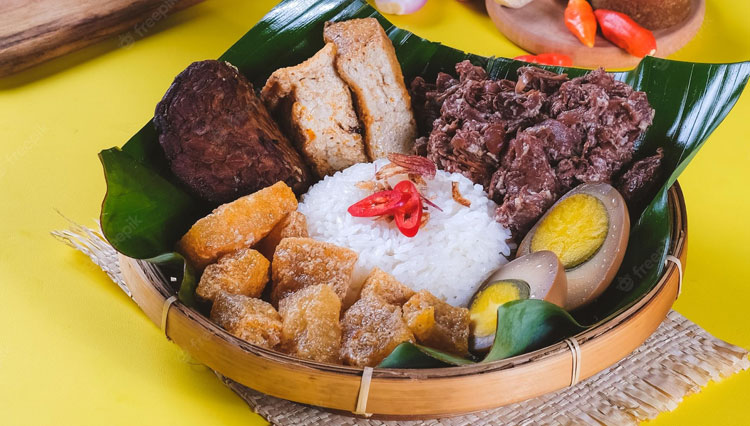The Story Behind Gudeg, a Traditional Cuisine from Yogyakarta

TIMESINDONESIA, JAKARTA – Gudeg is a traditional cuisine from Yogyakarta. The main ingredient of Gudeg is young unripe jackfruit, which is also known by the local as gori. The cooking process takes several hours over low heat.
Usually, Gudeg is served with various side dishes, such as krecek (traditional Javanese spicy cattle skin), egg, and braised spiced chicken.
The process of making this traditional dish should be done with precision. That’s why cooking a perfect Gudeg can take all day, which is actually reflecting the Javanese philosophy of calmness, patience, and meticulousness.
Cited from Indonesian Travel, just like most Indonesian food, Gudeg is usually served with rice. Some mandatory side dishes served with Gudeg may include Sambel Goreng Krecek (crispy beef skins fried with peanuts and chili), Opor Ayam (chicken curry served with coconut milk), Telur Pindang (seasoned boiled egg), tahu or tempe bacem (sweet braised, steamed tofu or tempe)
However, do you know the history of Gudeg? Based on several sources, there are several different versions of this traditional cuisine of Yogyakarta.
According to gudeg.net, Gudeg was created by Sultan Agung of Mataram before preparing themselves for the siege.
At that time, Mataram was planning to attack Batavia in the Siege of Batavia. They had to go on a long-distance trip to get there. Therefore, they have to prepare themselves some food that can last for long days. Gudeg can last for several days as it is slowly and thoroughly cooked.
Meanwhile, National Geographic said that Gudeg was created in the 15th century, during the reign of Islamic Mataram Kingdom in Mentaok, Kotagede in Yogyakarta.
Professor Murdijati Gardjito, a professor in the Center for Traditional Food Studies (PKMT) of UGM stated that Gudeg was pioneered by a soldier who found abundant resources of young unripe jackfruit, coconut, and melinjo nuts.
“During the establishment of Mataram Kingdom in Mentaok, there were many trees being cut down. Most of them are jackfruit trees, coconut trees and melinjo trees. The soldiers collected them and cooked them, creating a cuisine called Gudeg,” said Murdijati who also the writer of a book titled Gudeg Yogyakarta .
On her book, Murdijati also explained the origin of the name ‘Gudeg’. The name ‘Gudeg’ came from how the ingredients are being stirred.
“Hangudeg means ‘stirring’ in Javanese. Then, people usually call it ‘gudeg’,” he stated.
Gudeg had also been mentioned in Serat Centhini. It is said that this food was usually served to the guests of Mataram Kingdom in the 16th century.
For additional information, Serat Centhini was written in 1814 - 1823 under the command of Adipati Anom Amangkunegara III, who then became the king of Keraton Kasunanan Surakarta with the title of Sunan Pakubuwono V.
In this book, the ingredients of Gudeg was written in detail. The ingredients include young unripe jackfruit, bay leaves, lime leaves, galangal, coconut milk, candleberry, coriander, shrimp paste, cumin, and salt.
Until now, Gudeg has been served in various ways. Traditionally, Gudeg is served in ‘kendil’ (a pot-like container made from clay). Some also serve it in ‘besek’ (a bucket made of bamboo). In these modern days, Gudeg was also served in a tin packaging. (*)
**) Ikuti berita terbaru TIMES Indonesia di Google News klik link ini dan jangan lupa di follow.
Advertisement
| Publisher | : Lucky Setyo Hendrawan |


